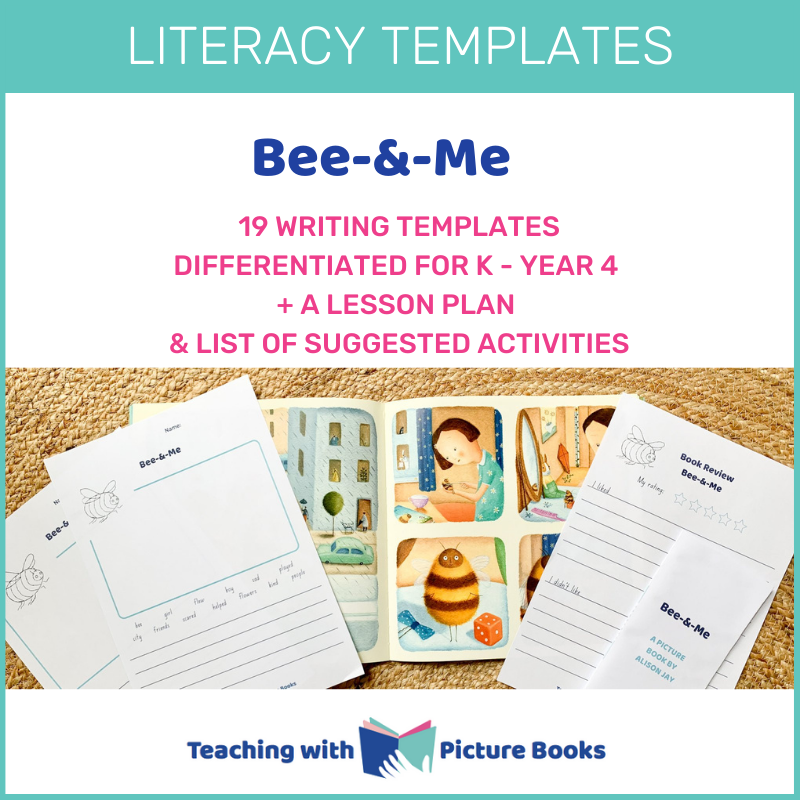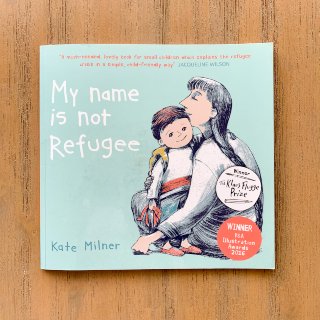Bee & Me
Free lesson plan, writing template & printable word-search puzzles for kids
Best suited to:
K – Year 4
KLAs covered:
English (narrative), science, sustainability, PDH (friendship)
Learning:
- what do bees need?
- what do bees do?
- why are they important?
- what does friendship mean?
- point of view in texts: a story can be told from different points of view;
- visual literacy: inferring and making meaning from information presented in the form of images;
Need to know:
- this is a wordless picture book;
- the story is about a little girl who befriends a bee and learns about friendship and nature;
- the illustrations are extremely detailed and show the changing seasons;
- this is a good text to use as an introduction to a unit or one-day study of bees;
Discussion Questions (before reading):
- what do you think this book will be about? what makes you think that?
- do you think this book will be a fiction text or non-fiction? what makes you think that?
- what do you know about bees? what do they do?
- this book doesn’t have any words. The story is told in pictures. Why do you think the author/illustrator might have chosen to do this?
Reading the book:
- wordless picture books require children to observe carefully and to think quite deeply about what is happening in the illustrations and the story they are telling;
- the aim when reading a wordless picture book is to have the children tell the story;
- there are no ‘right’ or ‘wrong’ ways to read a wordless book. Each child creates her own story from the same pictures;
- allow plenty of time for the children to look at the images before asking them to tell you what they can see;
Tips for reading Bee & Me:
- begin by taking a ‘picture walk’ through the pages of the book. Enjoy the illustrations and look at the expressions on the characters’ faces, the settings and the colours used;
- during the ‘picture walk’, enjoy the pictures together, point out a few things and get a sense of what the book is about but don’t worry too much about the story;
- go back through the book a second time and encourage the children to ‘read’ the book with you;
- ask the children what they think the bee is saying and what they think the little girl might be saying;
- show the children the first double-page spread (of the city) and tell them to take some time to look at the picture. Ask them to tell the class what they can see;
- turn the page and ask the children what is happening in the first image (people in their apartments);
- move on to the three images on the next page and point out the sequence of the images. What do they show happening?
- keep “reading” the story together in this way;
- every so often ask the children to predict what they think will happen next;
- also ask the children how they think the bee is feeling in some of the images. How do they think the little girl feels? What can they see that makes them think this?
Discussion Questions (after reading):
- what is the setting for this book? Is it set in more than one place?
- where did the bee want to be? Why?
- did the city look different at the end of the book from the way it looked at the beginning? Why? What had happened to change it?
- what time of year do you think it is in the book? Which pictures tell you that?
- what message do you think the author was trying to tell us in the book?
- did you like the fact that the book didn’t have any words? Why or why not?
- are bees important? Why or why not? What do they do?
- how would you describe the little girl? What sort of person is she? (kind, caring, observant, happy, playful, helpful, brave);
- read and discuss the information about bees on the last page of the book;
- do you think the bee and the girl are friends? What do they do which shows us this?
Activities:
The children can complete these activities in their books, on blank paper or you can use our literacy templates which have been specially created to use with Bee-&-Me.
- children draw and/or retell/describe their favourite part of the story;
- children describe the friendship between the girl and the bee;
- children draw and/or write about the way the city changed during the story;
- children write the story as if they are the authors;
- as a class discuss the character of the little girl. Children write a description of the little girl and illustrate;
- discuss point of view (POV) in texts: what is it and why it makes a difference to the way we respond to stories. What are the different points of view from which this story be told? Children can write the story from the little girl’s POV or from the bee’s POV;
- choose a page from the book and ask the children to write their own story based on what is happening in the picture;
- choose a page from the book and ask the children to draw it and to use speech bubbles to show what they think the bee and the little girl might be saying. Model using speech bubbles on the whiteboard when you introduce the activity;
- children write a diary/journal entry from the bee’s POV or from the little girl’s POV. Discuss diaries/journals and diary entries first. What is a diary? Why do people keep diaries? Discuss and model the format of a diary entry on the whiteboard (written in first person, beginning eg Dear Diary … or simply the date and Today I … ) ;
Free, printable word-search puzzles
These free printable word-search puzzles for kids are great for building and reinforcing the vocabulary used when you’re discussing Bee-&-Me.
There are three different puzzles in this file to enable you to differentiate the activity according to the needs of your students.
Free writing template
You can download and print our free writing template for use with Bee-&-Me here (PDF).








